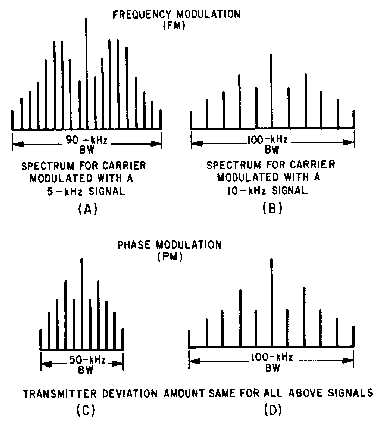2-25
Figure 2-21.—Fm versus pm spectrum distribution.
In phase modulation the oscillator does not deviate, and the power in the sidebands is a function of
the amplitude of the modulating signal. Therefore, two signals, one at 5 kilohertz and the other at 10
kilohertz, used to modulate a carrier would have the same sideband power distribution. However, the
10-kilohertz sidebands would be farther apart, as shown in views (C) and (D) of figure 2-21. When
compared to fm, the bandwidth of the pm transmitted signal is greatly increased as the frequency of the
modulating signal is increased.
As we pointed out earlier, phase modulation cannot occur without an incidental change in frequency,
nor can frequency modulation occur without an incidental change in phase. The term fm is loosely used
when referring to any type of angle modulation, and phase modulation is sometimes incorrectly referred
to as "indirect fm." This is a definition that you should disregard to avoid confusion. Phase modulation is
just what the words imply — phase modulation of a carrier by an af modulating signal. You will develop
a better understanding of these points as you advance in your study of modulation.
Basic Modulator
In phase modulation you learned that varying the phase of a carrier at an intelligence rate caused that
carrier to contain variations which could be converted back into intelligence. One circuit that can cause
this phase variation is shown in figure 2-22.

